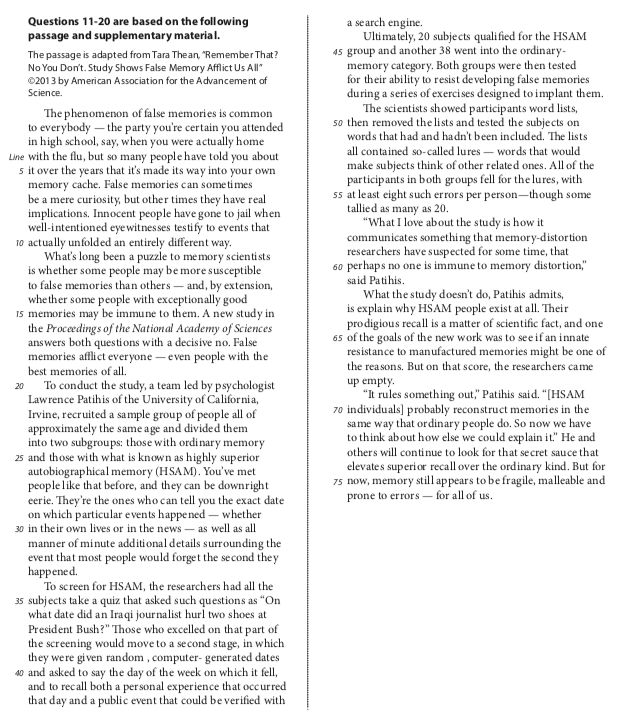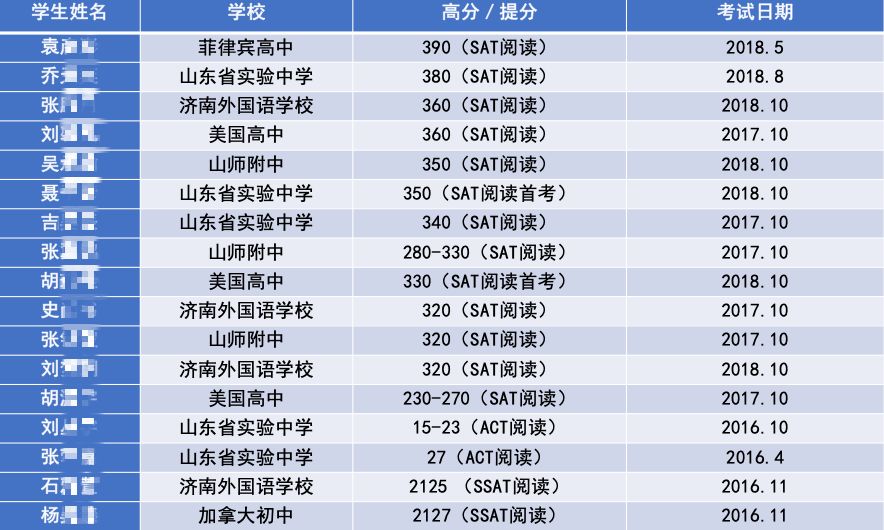
3月考试在即,为了让大家抓紧最后这几天的机会,给大家一个福利,今天可是满满的干货,所以大家仔细往下看!


学过SAT的同学都知道,科学文章占五篇文章的三篇,大比重,所以科学文章是第一次考试的高二同学要着重关注的文章类型。但是好消息是,科学文章却也是最有套路的一种文体,怎么个【套路】法呢?

通过对真题所有科学文章进行统计发现,科学文章(包括自然科学和社会科学)三分之二的比例的文章都是在做实验。实验类的文章是大比重,而这类文章一般都符合如下套路规律:
1. 背景
2. 实验目的
3. 实验发现(提前剧透)
4. 实验
a. 实验假设
b. 实验setting设置
c. 实验过程
d. 实验结果
5. 结果分析
6. 他人评价
7. 意义应用
8. 还有问题
(一般文章按照如此顺序,但可以灵活调整顺序)
这八点是统计发现最多出现的8点信息,而我们平时练习的时候需要做的就是通过对于文章和题目的【练习】能够【熟练辨认】。
现在我们以一篇文章为例,来感受一下SAT的实验类科学文章是如何套路满满的。
这篇文章是18年5月亚太的第二篇实验类科学文章:

Para 1:
The phenomenon of false memories is common to everybody — the party you’re certain you attended in high school, say, when you were actually home with the flu, but so many people have told you about it over the years that it’s made its way into your own memory cache. False memories can sometimes
be a mere curiosity, but other times they have real implications. Innocent people have gone to jail when well-intentioned eyewitnesses testify to events that actually unfolded an entirely different way.
第一段很明显像托福写作的开头段,以现在社会上的现象开头引出话题,所以概括为【背景】,作用就是引出话题【false memory】。
1
Para 2:
What’s long been a puzzle to memory scientists is whether some people may be more susceptible to false memories than others — and, by extension, whether some people with exceptionally good memories may be immune to them. ////A new study in the Proceedings of the National Academy of Sciences answers both questions with a decisive no. False memories afflict everyone — even people with the best memories of all.
第二段注意一个明显的标志词【puzzle】,让科学家困惑的一个事情。为什么作者要要在文章开头部分就写这句话呢。目的就是告诉readers,提出这个问题,那么接下来我就是要来讨论这个问题,才写这篇文章的。所以概括为【实验目的】。
另外还有标志词【a new study answers…】,SAT真题里的科学文章作者有一个习惯,就是提前剧透实验发现,所以看到这种表达,就是提前先告知读者研究的结果,所以概括为【实验发现(提前剧透)】。
2

Para 3:
To conduct the study, a team led by psychologist Lawrence Patihis of the University of California, Irvine, recruited a sample group of people all of approximately the same age and divided them into two subgroups: those with ordinary memory and those with what is known as highly superior autobiographical memory (HSAM). You’ve met people like that before, and they can be downright eerie. They’re the ones who can tell you the exact date on which particular events happened — whether in their own lives or in the news — as well as all manner of minute additional details surrounding the event that most people would forget the second they happened.
第三段里人名的出现,很大几率代表实验介绍的开始,并且进行【控制变量】的分组:实验组和控制组。这种做实验的方法也是作者经常爱用的方法。所以这段概括成【实验设置setting】。
3

Para 4:
To screen for HSAM, the researchers had all the subjects take a quiz that asked such questions as “On what date did an Iraqi journalist hurl two shoes at President Bush?” Those who excelled on that part of the screening would move to a second stage, in which they were given random, computer- generated dates and asked to say the day of the week on which it fell, and to recall both a personal experience that occurred that day and a public event that could be verified with a search engine.
第四段注意里面的一些动作,比如“screen, take a quiz, ask questions, move to, ask, recall”这些动作代表了【实验过程】。
4

Para 5:
Ultimately, 20 subjects qualified for the HSAM group and another 38 went into the ordinary- memory category. Both groups were then tested
for their ability to resist developing false memories during a series of exercises designed to implant them.
这一段其实是对上段的承接结果,还是属于【实验过程】,因为还有动作词“tested for their ability during a series of exercises”.
5

Para 6:
The scientists showed participants word lists, then removed the lists and tested the subjects on words that had and hadn’t been included. The lists all contained so-called lures — words that would make subjects think of other related ones. All of the participants in both groups fell for the lures, with at least eight such errors per person—though some tallied as many as 20.
第六段里的标志词【The scientists showed …】以及【All of the participants fell for…】所以能看出这一段是【实验结果】。
6

Para 7:
“What I love about the study is how it communicates something that memory-distortion researchers have suspected for some time, that perhaps no one is immune to memory distortion,” said Patihis.
这一段是一个人的话,一般看到这种形式,就会想到【他人评价】,正常的文章中他人评价有正有负,都有可能,因为科学是一个open to discussion 的话题,所以都可以评价。只不过这里的人Patihis,就是之前做实验的人,所以是【自己的评价】,而且是正态度,因为文中【what I love is…】这种表达。
7

Para 8:
What the study doesn’t do, Patihis admits,
is explain why HSAM people exist at all. Their prodigious recall is a matter of scientific fact, and one of the goals of the new work was to see if an innate resistance to manufactured memories might be one of the reasons. But on that score, the researchers came up empty.
第八段里的标志词【What the study doesn’t do is …】也就是这个实验还没有做的事情,或者还没有解决的事情,在其他的文章中也可以是这个实验有问题之处,那这就可以概括成套路的【还有问题】,而这里经常会出题,【还有问题】能够暗示出的就是【further research is needed.】
8

Para 9:
“It rules something out,” Patihis said. “[HSAM individuals] probably reconstruct memories in the same way that ordinary people do. So now we have to think about how else we could explain it.” He and others will continue to look for that secret sauce that elevates superior recall over the ordinary kind. But for now, memory still appears to be fragile, malleable and prone to errors — for all of us.
最后一段一般是我们印象中的总结段,其实这里也是,里面的标志词【So now we have to think about …】以及【He and others will continue to look for】,这里和上一段想说的话也是一样的【further research is needed.】
9

所以最后我们来梳理一下这篇文章的结构:
背景➡实验目的➡实验发现➡实验设置➡实验过程➡实验结果➡自己评价➡还有问题
在这里要注意一点,并不是每篇文章都会有我在一开始写的那8点套路,有些文章只会选取一部分来写.
这篇文章的结构很清晰,也是很符合我们的套路,里面的实验设置、过程、结果比较好找出来,但是目的、还有问题,这就比较隐晦了。
所以要看懂一篇文章的前提,是要知道最常见的文章结构长什么样,然后在此基础上,针对不同的文章灵活地来练习,希望大家不断练习,自我消化。也希望大家能在这次12月的首考或者最后一次考试中取得不让自己后悔的分数!

教师介绍:
李明昱
教授科目: SAT阅读|词汇/ACT阅读/SSAT阅读
教育背景: 英语文学专业,剑桥商务英语高级,英语专业八级优秀,教师资格证书
教学简介: 教龄四年,上课总时常达4000多小时,济南新东方学校SAT阅读题库主编以及教研组长。研修教育心理学,独创的阅读方法与做题技巧能使学生轻松应对SAT考试,擅长提分,强调能力与分数并重。极其注重结课后的跟盯,对结课后的学生进行长期的答疑解惑。教学认真负责,教研细致深入,课堂质量与课下服务并重,高分学员众多。
高分提分学员:

附上SAT百人模考报名二维码!!抓紧扫下方二维码预约!

想要了解更多“留学、AP、国际班”相关课程,
扫描下方二维码加大队长为好友,

大队长等你撩~



 3月考试在即,为了让大家抓紧最后这几天的机会,给大家一个福利,今天可是满满的干货,所以大家仔细往下看!
3月考试在即,为了让大家抓紧最后这几天的机会,给大家一个福利,今天可是满满的干货,所以大家仔细往下看!
 学过SAT的同学都知道,科学文章占五篇文章的三篇,大比重,所以科学文章是第一次考试的高二同学要着重关注的文章类型。但是好消息是,科学文章却也是最有套路的一种文体,怎么个【套路】法呢?
学过SAT的同学都知道,科学文章占五篇文章的三篇,大比重,所以科学文章是第一次考试的高二同学要着重关注的文章类型。但是好消息是,科学文章却也是最有套路的一种文体,怎么个【套路】法呢?


 教师介绍:
教师介绍:









